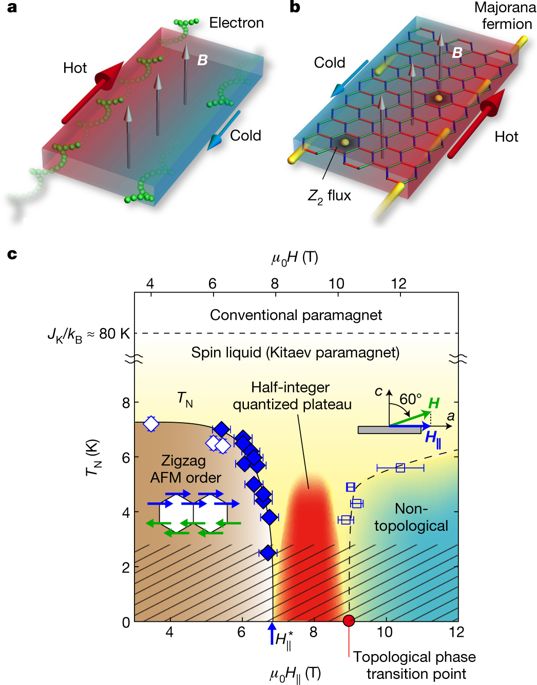Our official English website, www.x-mol.net, welcomes your
feedback! (Note: you will need to create a separate account there.)
Majorana quantization and half-integer thermal quantum Hall effect in a Kitaev spin liquid
Nature ( IF 50.5 ) Pub Date : 2018-07-01 , DOI: 10.1038/s41586-018-0274-0 Y. Kasahara , T. Ohnishi , Y. Mizukami , O. Tanaka , Sixiao Ma , K. Sugii , N. Kurita , H. Tanaka , J. Nasu , Y. Motome , T. Shibauchi , Y. Matsuda
Nature ( IF 50.5 ) Pub Date : 2018-07-01 , DOI: 10.1038/s41586-018-0274-0 Y. Kasahara , T. Ohnishi , Y. Mizukami , O. Tanaka , Sixiao Ma , K. Sugii , N. Kurita , H. Tanaka , J. Nasu , Y. Motome , T. Shibauchi , Y. Matsuda

|
The quantum Hall effect in two-dimensional electron gases involves the flow of topologically protected dissipationless charge currents along the edges of a sample. Integer or fractional electrical conductance is associated with edge currents of electrons or quasiparticles with fractional charges, respectively. It has been predicted that quantum Hall phenomena can also be created by edge currents with a fundamentally different origin: the fractionalization of quantum spins. However, such quantization has not yet been observed. Here we report the observation of this type of quantization of the Hall effect in an insulating two-dimensional quantum magnet1, α-RuCl3, with a dominant Kitaev interaction (a bond-dependent Ising-type interaction) on a two-dimensional honeycomb lattice2–7. We find that the application of a magnetic field parallel to the sample destroys long-range magnetic order, leading to a field-induced quantum-spin-liquid ground state with substantial entanglement of local spins8–12. In the low-temperature regime of this state, the two-dimensional thermal Hall conductance reaches a quantum plateau as a function of the applied magnetic field and has a quantization value that is exactly half of the two-dimensional thermal Hall conductance of the integer quantum Hall effect. This half-integer quantization of the thermal Hall conductance in a bulk material is a signature of topologically protected chiral edge currents of charge-neutral Majorana fermions (particles that are their own antiparticles), which have half the degrees of freedom of conventional fermions13–16. These results demonstrate the fractionalization of spins into itinerant Majorana fermions and Z2 fluxes, which is predicted to occur in Kitaev quantum spin liquids1,3. Above a critical magnetic field, the quantization disappears and the thermal Hall conductance goes to zero rapidly, indicating a topological quantum phase transition between the states with and without chiral Majorana edge modes. Emergent Majorana fermions in a quantum magnet are expected to have a great impact on strongly correlated quantum matter, opening up the possibility of topological quantum computing at relatively high temperatures.Half-integer quantization of the thermal Hall effect in a Kitaev spin liquid reveals chiral currents of charge-neutral Majorana fermions around the edges of the sample, produced by strong electronic correlations.
中文翻译:

Kitaev 自旋液体中的 Majorana 量子化和半整数热量子霍尔效应
二维电子气中的量子霍尔效应涉及沿样品边缘流动的受拓扑保护的无耗散电荷电流。整数或分数电导分别与电子或具有分数电荷的准粒子的边缘电流相关。据预测,量子霍尔现象也可以由具有根本不同起源的边缘电流产生:量子自旋的分数化。然而,这种量化还没有被观察到。在这里,我们报告了对绝缘二维量子磁体 α-RuCl3 中霍尔效应的这种量子化的观察,在二维蜂窝晶格上具有主要的 Kitaev 相互作用(依赖于键的 Ising 型相互作用)2– 7. 我们发现平行于样品的磁场的应用破坏了长程磁序,导致场诱导的量子-自旋-液体基态与局部自旋的大量纠缠 8-12。在该状态的低温状态下,二维热霍尔电导达到作为外加磁场函数的量子平台,并且其量化值恰好是整数量子的二维热霍尔电导的一半霍尔效应。散装材料中热霍尔电导的这种半整数量化是电荷中性马约拉纳费米子(粒子是它们自己的反粒子)的拓扑保护手征边缘电流的特征,其自由度是传统费米子的一半 13-16 . 这些结果表明自旋被细分为流动的马约拉纳费米子和 Z2 通量,这预计会发生在 Kitaev 量子自旋液体 1,3 中。在临界磁场之上,量子化消失,热霍尔电导迅速变为零,表明具有和不具有手性马约拉纳边缘模式的状态之间存在拓扑量子相变。预计量子磁体中出现的马约拉纳费米子将对强相关量子物质产生重大影响,为在相对高温下拓扑量子计算开辟了可能性。 Kitaev 自旋液体中热霍尔效应的半整数量化揭示了手性电流样品边缘周围的电荷中性马约拉纳费米子,由强电子相关性产生。
更新日期:2018-07-01
中文翻译:

Kitaev 自旋液体中的 Majorana 量子化和半整数热量子霍尔效应
二维电子气中的量子霍尔效应涉及沿样品边缘流动的受拓扑保护的无耗散电荷电流。整数或分数电导分别与电子或具有分数电荷的准粒子的边缘电流相关。据预测,量子霍尔现象也可以由具有根本不同起源的边缘电流产生:量子自旋的分数化。然而,这种量化还没有被观察到。在这里,我们报告了对绝缘二维量子磁体 α-RuCl3 中霍尔效应的这种量子化的观察,在二维蜂窝晶格上具有主要的 Kitaev 相互作用(依赖于键的 Ising 型相互作用)2– 7. 我们发现平行于样品的磁场的应用破坏了长程磁序,导致场诱导的量子-自旋-液体基态与局部自旋的大量纠缠 8-12。在该状态的低温状态下,二维热霍尔电导达到作为外加磁场函数的量子平台,并且其量化值恰好是整数量子的二维热霍尔电导的一半霍尔效应。散装材料中热霍尔电导的这种半整数量化是电荷中性马约拉纳费米子(粒子是它们自己的反粒子)的拓扑保护手征边缘电流的特征,其自由度是传统费米子的一半 13-16 . 这些结果表明自旋被细分为流动的马约拉纳费米子和 Z2 通量,这预计会发生在 Kitaev 量子自旋液体 1,3 中。在临界磁场之上,量子化消失,热霍尔电导迅速变为零,表明具有和不具有手性马约拉纳边缘模式的状态之间存在拓扑量子相变。预计量子磁体中出现的马约拉纳费米子将对强相关量子物质产生重大影响,为在相对高温下拓扑量子计算开辟了可能性。 Kitaev 自旋液体中热霍尔效应的半整数量化揭示了手性电流样品边缘周围的电荷中性马约拉纳费米子,由强电子相关性产生。











































 京公网安备 11010802027423号
京公网安备 11010802027423号